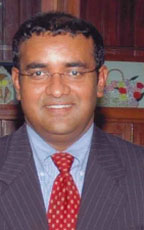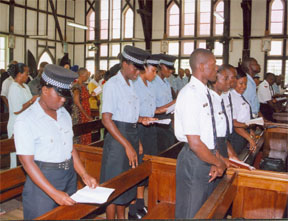The defining public security incident of 2009 was the torture of a boy by the police. The Makhanlall Report shows us the sort of police force we have. The question is what sort of force do we want?
It took more than one awful night at Leonora – the 28th of October – for Guyanese to ask themselves the question, “What sort of police force do we want in this country? It was on that night that the chain of events that began with the murder of People’s Progressive Party stalwart and former Vice-Chairman of the Essequibo Islands-West Demerara Region Ramenauth Bisram came to its cold-blooded climax.
As a consequence, the reputation of the Guyana Police Force as the institution to which the people could look for ‘service and protection’ unravelled.
Report
The Report on the torture of persons at the Leonora Police Station was finally released by the Ministry of Home Affairs on 8th December 2009. Written by former Assistant Commissioner Heeralall Makhanlall who is Head of the Police Office of Professional Responsibility, the Report’s findings obliged the Ministry to acknowledge that the crime of torture did actually occur.

The Report confirmed that the fifteen-year-old boy was taken into custody at the La Grange Police station on 28th October in relation to Bisram’s murder. He was taken then to the Leonora Police Station where he was stripped and beaten before being burnt in his genital area. He was then taken to the Vreed-en-Hoop police station. Sometime afterwards, he was taken to the hospital to receive medical treatment.
Sometime during the night of his ordeal, an unidentified person photographed the injured by’s body. Only after an attorney at law raised the alarm and, three days after being burned, the press published a full frontal photograph of the boy on 31st October did police and government officials speak about the crime. The publicity, as much as the atrocity, ignited a controversy.
The questions of policing in general, and the conduct of the Force’s Criminal Investigation Department in particular, are not new and the ‘Leonora Incident’ is not the first time that allegations of torture have been levelled against the Guyana Police Force. The difference is that officials dismissed previous reports. But, this time, coming after a decade of unexplained extra-judicial killings and allegations of collaboration between rogue policemen and self-confessed narco-traffickers during the protracted troubles on the East Coast, these fresh allegations of torture triggered unusual public anger.
The response of Minister of Home Affairs Clement Rohee to questions about the torture of Buxtonians − Patrick Sumner and Victor Jones − in December 2007 was typical of official attitudes. The minister said then that Guyanese were more concerned about the goodies arriving in their barrels from overseas, acquiring a house lot and their own home, than the torture of the men by the security forces.
The response of Minister of Agriculture Robert Persaud to another incident involving three members of the Guyana Defence Force − Alvin Wilson, Sharth Robertson and Michael Dunn who also complained of having been tortured, reflected a similar attitude.
When the motion entitled ‘Allegations of torture made against the Joint Services of Guyana’ and tabled by Aubrey Norton of the People’s National Congress Reform was debated in the National Assembly, Persaud declared brazenly that the claims by some of the alleged victims had been found to be “false.” He added that the inquiry had found cases of “roughing up” but then tried to justify the abuses by suggesting that, in light of the “new face of criminality,” the security forces would use “a certain amount of physical and mental pressure” in order to get information, while insisting that such measures did not fit the definition of torture.

By a strange coincidence, the ‘Leonora Incident’ on 28th October 2009 seemed to be a reflection of the debate in the National Assembly that took place on 27th October 2008, almost exactly one year before.
President Bharrat Jagdeo himself, in November last year, asserted that his administration “does not view any of the reports [of the injuries to the Buxtonians] that had been circulating as ‘torture’ reports.” He suggested that the country needed “to understand the context of the torture allegations.” This time around, the President described the ‘Leonora Incident’ as “a terrible stain” and agonized about “the damage that it does to the reputation of the Police Force and the image that we are trying to create.”
For his part, Commissioner of Police Henry Greene lamented that the Police Force had suffered as a result of the allegations of torture. He said “All of us are being castigated because a few ranks decided that they are going to commit an act that is not proper…not right.” He admitted that “…sometimes in your anxiety to get things done, to solve a murder or a heinous crime, some of these ranks go overboard. They go beyond what they should be doing…”
Schools of thought
There are two schools of thought about how the police should respond to the threat of criminal violence. Simply, the division between the two schools corresponds to the division between different ways of thinking about the concepts of human rights and public security which should be complementary and not contradictory. It is in this regard that the police mentality that led to the ‘Leonora Incident’ on 28th October in which a 15-year-old boy was tortured by the representatives of a democratic state should be considered.
The big question − apart from the remarks of Rohee, Persaud and Jagdeo − is whether the use of force to elicit a confession for any crime can ever be justified. The fact that it occurred at all − not merely because it ignited a policing and public relations disaster − raises important questions of principle. It is shocking for torture to be used by the
security forces on any occasion and the public should not believe that this was an isolated act of misconduct by a few rogues. The police force iself must get its thinking straight about the implications of what happened.
On the one hand, adherents of the ‘human-rights’ school of thought usually take the view that the police should operate only under the strictest legal constraints that characterise democratic states. According to this school, human rights are more important than public security.
On the other hand, proponents of the ‘brute force’ school of policing take the view that the chief responsibility of the police is to safeguard the security of citizens. If this can be done only through allowing the police the flexibility to shoot to kill suspects, to ‘rough up’ detainees and to turn a blind eye to torture then, so be it.
In this school, the occasional torture of suspects is a price worth paying if it reduces the threat from violent criminals. Even if some members of the public – like the boy in question – are put at risk by more aggressive forms of policing, this is a price worth paying as long as the level of public security is increased in the long-run.
When the ‘brute-force’ argument has been applied over the past decade, even to the extent of killing suspects on a grand scale, there was no great objection or outcry as can be heard today. This suggested that consequences are paramount and that almost any course of action that makes society safer is permissible even at the cost of suspects’ lives.
The two schools of thought seemed to collide at the 24th annual conference of the Association of Caribbean Commissioners of Police here in Georgetown in May. The current President of the Association and Barbados’s Commissioner of Police, Darwin Dottin, dealt directly with the philosophy of law enforcement in the region.
Clearly an adherent of the ‘human rights’ school, Dottin declared plainly that “As police organisations, we are not fighting a war against our citizens. Even though they are provoked, in most cases police officers are working in a conflictual position…we think that their training is as such that they would be able to deal with those persons with whom they come into contact in a respectful manner.”
Although his remarks referred to the entire Commonwealth Caribbean, Dottin seemed to point to the whole purpose of public security and to the direction that police reform should take.
Speaking at the same conference, President Jagdeo seemed to belong to the other school. The President pronounced that “the use of brute force” was justified because of the escalation of violent crime in which AK-47s were being used. He declaimed, “…when you have psychopaths slaughtering people, then you need brute force. When you have someone shooting at you with AK-47s you need to send out the brute force AK-47s to get back at them. You can’t go there and smile and shake hands and negotiate, welcome them to the fold; they are not going to come.”
No one would advocate that criminals armed with assault rifles should not be confronted with force. Dottin himself was at pains to point out that he was not advocating “soft policing” because, in some cases, “firm policing” was required. The problem arises in those cases when even though suspects have been cornered or detained in police stations and are incapable of harming their captors, they have been beaten and tortured.
Carte blanche
The point that the ‘brute force’ school of thought misses is that the police ought to care as much about how outcomes are brought about as it cares about outcomes. For members of the public, there is an enormous difference between being a victim of a violent criminal attack, as in the ‘Lusignan atrocity’ and, as in the ‘Leonora Incident,’ being a victim of torture that is inflicted by the agents of the state to which they belong.
When the ‘brute force’ sort of rationalisation percolates through the ranks of the police, disasters like the ‘Leonora Incident’ are likely to occur. For, it seems, the police have too often felt that, once the political authorities and the police administration do not actively criticize their conduct and punish wrongdoers, they have carte blanche to do as they please.
What is at stake ultimately is the central feature of human society – the liberty and personal security of all the Guyanese people. These are not rights that can be lightly traded even in return for the promises of public safety protection against criminals, including potential murderers, by the police. In the long term, the Guyanese people must determine what sort of country we want to live in and what sort of police force we want to have?





